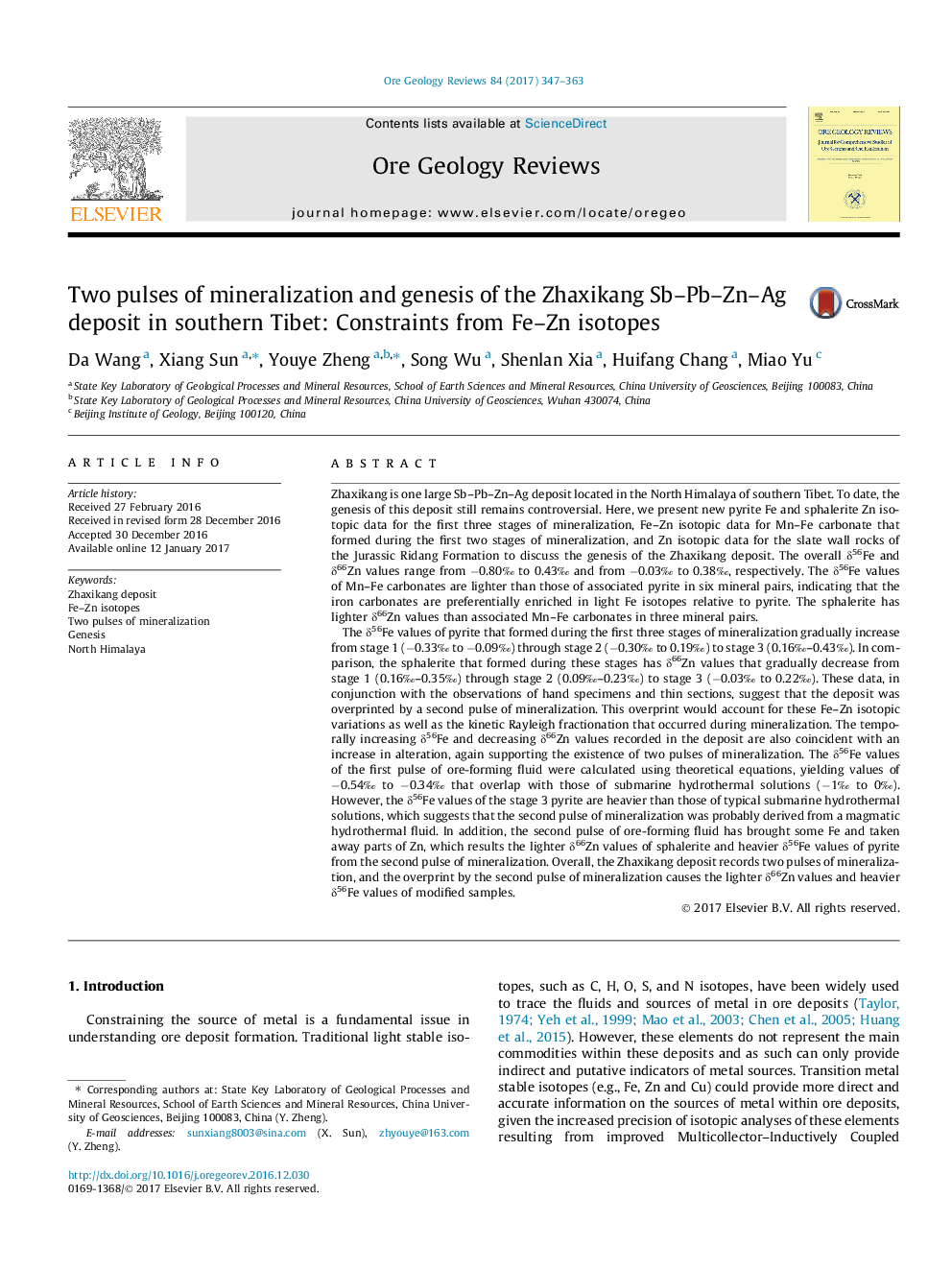| کد مقاله | کد نشریه | سال انتشار | مقاله انگلیسی | نسخه تمام متن |
|---|---|---|---|---|
| 5782473 | 1637223 | 2017 | 17 صفحه PDF | دانلود رایگان |

- Within same mineral pair, pyrite is enriched heavy Fe isotopes relative to Mn-Fe carbonate.
- Within same mineral pair, sphalerite is enriched light Zn isotopes relative to Mn-Fe carbonate.
- The second-pulse overprint plays an important role in Fe-Zn isotopic variations.
- There are two pluses of mineralization in the Zhaxikang deposit with different metal sources.
Zhaxikang is one large Sb-Pb-Zn-Ag deposit located in the North Himalaya of southern Tibet. To date, the genesis of this deposit still remains controversial. Here, we present new pyrite Fe and sphalerite Zn isotopic data for the first three stages of mineralization, Fe-Zn isotopic data for Mn-Fe carbonate that formed during the first two stages of mineralization, and Zn isotopic data for the slate wall rocks of the Jurassic Ridang Formation to discuss the genesis of the Zhaxikang deposit. The overall δ56Fe and δ66Zn values range from â0.80â° to 0.43â° and from â0.03â° to 0.38â°, respectively. The δ56Fe values of Mn-Fe carbonates are lighter than those of associated pyrite in six mineral pairs, indicating that the iron carbonates are preferentially enriched in light Fe isotopes relative to pyrite. The sphalerite has lighter δ66Zn values than associated Mn-Fe carbonates in three mineral pairs.The δ56Fe values of pyrite that formed during the first three stages of mineralization gradually increase from stage 1 (â0.33â° to â0.09â°) through stage 2 (â0.30â° to 0.19â°) to stage 3 (0.16â°-0.43â°). In comparison, the sphalerite that formed during these stages has δ66Zn values that gradually decrease from stage 1 (0.16â°-0.35â°) through stage 2 (0.09â°-0.23â°) to stage 3 (â0.03â° to 0.22â°). These data, in conjunction with the observations of hand specimens and thin sections, suggest that the deposit was overprinted by a second pulse of mineralization. This overprint would account for these Fe-Zn isotopic variations as well as the kinetic Rayleigh fractionation that occurred during mineralization. The temporally increasing δ56Fe and decreasing δ66Zn values recorded in the deposit are also coincident with an increase in alteration, again supporting the existence of two pulses of mineralization. The δ56Fe values of the first pulse of ore-forming fluid were calculated using theoretical equations, yielding values of â0.54â° to â0.34â° that overlap with those of submarine hydrothermal solutions (â1â° to 0â°). However, the δ56Fe values of the stage 3 pyrite are heavier than those of typical submarine hydrothermal solutions, which suggests that the second pulse of mineralization was probably derived from a magmatic hydrothermal fluid. In addition, the second pulse of ore-forming fluid has brought some Fe and taken away parts of Zn, which results the lighter δ66Zn values of sphalerite and heavier δ56Fe values of pyrite from the second pulse of mineralization. Overall, the Zhaxikang deposit records two pulses of mineralization, and the overprint by the second pulse of mineralization causes the lighter δ66Zn values and heavier δ56Fe values of modified samples.
218
Journal: Ore Geology Reviews - Volume 84, April 2017, Pages 347-363